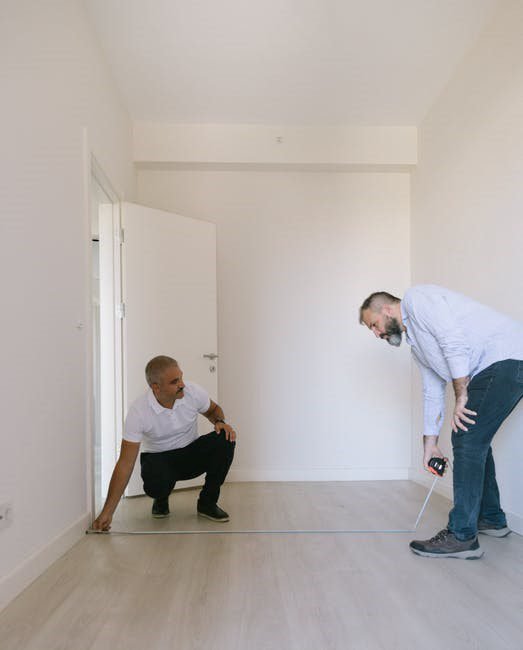Last Updated on March 1, 2023 by
Are you looking to upgrade the flooring in your home? Flooring can change the look of your home and can also give you a good return on investment if you plan to sell your home in the near future.
As you start your search for new flooring, it’s important to know how much flooring you need so you can budget correctly. Wondering how to measure for flooring? We’ve got you covered. Keep reading to learn more about how to measure a room so you can plan accordingly.
Table of Contents
Tools You Need
As you get ready, we recommend you grab another family member or friend to help hold the tape measure or write down measurements. You should write down your room totals and measurements as you go, and not wait until the end for everything.
Here are the tools you need:
- Tape measure
- Paper
- Pen or pencil
- Calculator
It’s also a good idea to draw a rough sketch of your rooms. You can then write the dimensions on the drawing. This can help the flooring company and you visualize the flooring to determine your needs as you select your flooring like laminate flooring.
Step 1: How to Measure for Flooring?
Not every room will be perfectly rectangular or square, so you want to start with the largest measurement and then work backward. You will subtract any area from the total that does not need flooring.
To get a rough estimate, you need to calculate the room’s gross square footage. Go with the longest wall first, and measure wall to wall (in both directions).
To get the gross area, you will multiply the length of the room by the width. To complete this measurement:
- Measure each room you need flooring for and calculate individually
- Measure the longest width from one wall to the next
- Measure the longest length between the other walls
- Then multiply the width by the length to get a rough estimate
For example, if your room’s width is 20 ft and the length is 15 ft (20×15=300 sq ft).
You want to be careful with rounding. You can order too much flooring or too little.
Step 2: Subtract the Area of Permanent Objects
To get an accurate estimate, you will need to account for flooring you do not need. This means you will subtract the floor space where you have permanent objects like a kitchen island, staircase, or fireplace.
To do this:
- Figure out the square footage of the object by multiplying the width x length
- Get the total area of unusable floor space
- Subtract it from the rough estimate of the room’s square footage
For example, for a kitchen island measuring 20 sq ft and the room’s square footage is 300 sq ft, you would take 300-20= 280 sq ft of flooring needed.
Step 3: Add All Room’s Measurements
You will complete Steps 1 and 2 for each room getting new flooring. Then add the square footage of all rooms to get the total amount of flooring you need.
Step 4: Factor in Waste
Almost all flooring projects have cuts to fit the space. This means you are going to have to factor in waste. The general rule is to figure you will need to add about 10 percent to account for this waste.
This buffer also gives you room for errors, making cuts, and any flooring that gets damaged during installation.
Additional Factors for Carpet
Most carpets come in 12′ rolls, but there are some that come in 13.5′ or 15′ widths. When you are selecting carpet, you should consider the width of your room to help cover wall to wall and eliminate seams.
If the carpet you select has a pattern, you will need to think about the seam so you can match the pattern. Patterns repeat ranging from 8″ up to 72″, so you will need to make sure you order enough carpet to match the pattern. To do this, you will measure the length of the pattern and then add it to your length measurement.
If you are adding carpet to the stairs, you need to measure the horizontal part, which is the tread, and the vertical part, which is the riser. Don’t forget to add any nosing, or overhang of the tread.
Multiply the measurement by the number of stairs. You should then account for 10 percent to cover the carpet padding on each tread. This is because the padding will slightly raise the stair height.
You want to try to get one continuous piece of carpet for stairs if possible. You can use scraps and carpet each stair individually with leftover material.
When measuring steps, you want a more flexible tape like the Stanley Reel Tape because you can wrap it around the steps. This tape is also handy for landscape projects as well.
Additional Factors for Tile
If you are getting tile, most tile is sold in boxes with 10 square feet of tile. You cannot buy a partial box.
You should consider the plus one rule, so you have at least a box leftover. Even if you have an extra half box, it would be handy to have an additional box as well to give you one and half boxes of extra tile.
You need to have a few tiles laying around in case you ever need to repair the tile. It may be hard to match this tile in the future as you never know if a color gets discontinued or is out of stock. You should also keep this box, so you know the shade and caliber information if you need to order more in the future.
Replacing Your Flooring and More
Now that you know how to measure for flooring it can help you determine the cost of flooring. New flooring can add a lot to your home’s aesthetics and can also get your home ready for a sale. There are so many options to choose from, so be sure to think about what style works best in that room and how much traffic flow that room gets.
Looking for more inspiration? Check out our Home Improvement section today for more ideas on how to make your home more stylish and comfortable.























